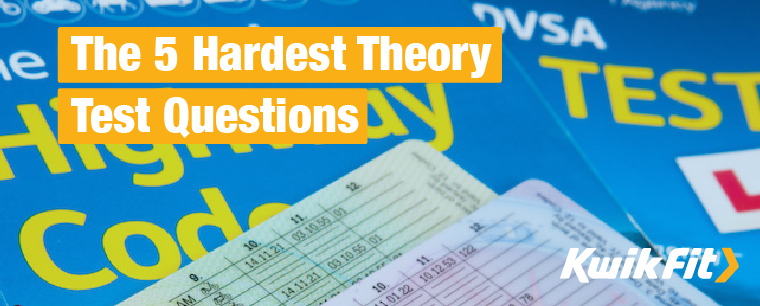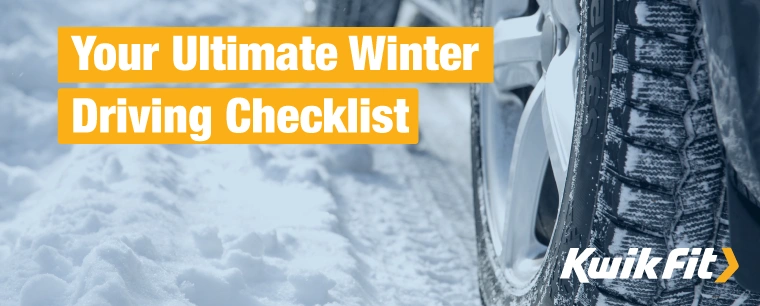The 5 Hardest Theory Test Questions
Jack Dreyer | Monday 29th January 2024 4:00pm

Did you know that only ??44.2% of candidates passed their driving theory test in the year ending March 2023? That’s a lot of resits — and demonstrates that more candidates fail than pass on average. That figure is also down 5.9 percentage points from the previous year.
While the theory test itself wasn’t designed to be ‘easy’, over the years, it has almost become almost notorious for its high fail rate.
We were curious to discover exactly which areas were stumping learners the most to allow us to offer some expert advice to any taking (or re-taking) their test. So, we looked at content from a number of motoring schools and theory test practice sites to determine some of the questions that learners seem to commonly slip up on.
If you’re trying to nail the theory test — from the hazard perception to the Highway Code — read on to find out which sections might require that bit more revision.
Theory test pass rates
In the year ending March 2023, driving theory tests had the lowest yearly pass rate in the published series (since 2013). The previous year was over 5% higher with a pass rate of 50.1% — both of which demonstrate a shocking decrease since 2013’s 55.7% pass rate.
Britain’s learners could use a little help, we think.
The driving theory test: An outline
If you’re looking to drive a car in the UK and you don’t already have a licence, you will need to pass the mandatory theory test alongside the practical.
The test comprises two sections designed to evaluate both theoretical knowledge of the Highway Code and responsiveness to driving hazards. To successfully pass a theory test, candidates must pass both sections which will be covered below.
Hazard perception
One of these sections is called ‘hazard perception’. This is a series of 14 video clips that each last about a minute. This section has a pass mark of 44 points out of a total of 75.
As the name would suggest, the hazard perception section assesses a candidate’s ability to anticipate and respond to upcoming road hazards. Candidates must watch a video on a screen and click their mouse in time when they notice a road hazard up ahead that requires action on the driver’s part.
This is a crucial element of the driving theory test as, shown from a driver’s viewpoint, the video simulates real-life situations featuring a number of hazards that drivers may have to respond to.
Some of the potential hazards include:
- Slow moving, wide load, or agricultural vehicles
- Vehicles suddenly turning into the road
- Unexpected cyclists
- Pedestrians crossing the road
- Children running into the road
- Livestock on the road
- Other road users up ahead
- Natural hazards such as flooding or debris
- Although often deemed the hardest part of the theory test, the hazard perception section gauges a candidate’s situational awareness and makes an essential contribution to road safety competency.
Multiple-choice questions
The other section of the driving theory test consists of a series of multiple-choice questions that are largely based on the Highway Code. There are 50 questions in this section, the pass mark is 43, and candidates have 57 minutes in total to complete it.
For each question, candidates must select the right answer from a number of possible responses. But, don’t be fooled by the apparent simplicity. Some of the responses are worded very similarly so that candidates have to read each option multiple times over to make sure that they actually choose the correct option.
Aside from this, three of the questions are focused around a short video, too. In this video, a driving scenario will be played (such as driving along a country road or through a town) and questions about the drive will be asked afterwards.
The hardest theory test questions
The multiple-choice section often throws up numerous problems for candidates sitting their theory test — be it due to difficult wording, very specific answers, or a necessary reliance on exactly what the Highway Code says.
We examined content from driving schools and test preparation sites across the country to determine which of these questions were tripping up candidates the most. You can find this list below — along with an indication of why each question posed a challenge and what the correct response looks like.
Armed with this knowledge, we hope that learners taking their theory test will feel more confident when it comes to answering even the most slippery of questions.

Question 1: Motorway rules
Q: You’ve broken down on a motorway. In which direction should you walk to find the nearest emergency telephone?
- With the traffic flow
- Facing oncoming traffic
- In the direction shown on the marker posts
- In the direction of the nearest exit
Answer
3 . In the direction shown on the marker posts.
This question poses a challenge to learners due to the fact that many learners do not actually have experience driving on motorways or smart motorways. If learners have been taking lessons informally— say, with a parent, older sibling, or a friend — they are not legally allowed to drive on the motorway and, therefore, are likely to have no experience on this road type.
In fact, the only way a learner can legally drive on a motorway is if they are accompanied by a licensed instructor in a dual-control car with visible L-plates. Add into the mix the fact that a practical driving test will not include any motorway driving, it is easy to see how questions about the motorways can throw candidates off easily.
Question 2: Stopping distances
Q: Overall stopping distance is made up of thinking distance and braking distance. You’re on a good, dry road surface, with good brakes and tyres. What’s the typical braking distance from 50 mph?
- 14 metres (46 feet)
- 24 metres (80 feet)
- 38 metres (125 feet)
- 55 metres (180 feet)
Answer:
3. 38 metres (125 feet).
Theory test questions where calculations are required — no matter how simple — often throw a spanner in the works for candidates. Unlike the majority of the questions where memory is tested, these calculation-based questions test a candidate’s ability to quickly apply the rules of the road to a real-life situation.
Candidates may, here, mistakenly click 55 metres, getting lured in by the 50 mph. For more information about braking distance, you can read all about it in another of our blogs here.
Question 3: Rules of the road
Q: Where may you overtake on a one-way street?
- Only on the left-hand side
- Overtaking isn’t allowed
- Only on the right-hand side
- On either the right or the left
Answer:
4. On either the right or the left side.
This appears to be a relatively simple question — and that’s why plenty of candidates slip up here. Sometimes, thinking about a question too much isn’t always a good idea. Overthinking can cause you to abandon your initial gut instinct or what you remember from revision and go with a random answer instead.
And that’s what happens here. It is tempting to say that ‘overtaking isn’t allowed’ — and we understand why. Since a one-way street only allows one stream of traffic to pass in one direction, there is usually the assumption that they are narrow and that you are unable to overtake on them. But this is not the case.
Should a vehicle be moving incredibly slowly (like an old tractor) or be broken down in a one-way street, other traffic still needs to be able to flow, which is why overtaking is allowed. And, since the traffic is all moving in one direction, this overtaking can be on any side — permitting it is done safely.
Heading 3 with Paragraph
Q: When can you park on the right-hand side of a road at night?
- When you’re in a one-way street
- When you have your sidelights on
- When you’re more than 10 metres (32 feet) from a junction
- When you’re under a lamppost
Answer:
1. When you’re in a one-way street
Due to the specificity of the multiple-choice answers provided, this question seems to confuse candidates a lot, again causing them to overthink things.
Throw in the curve-ball answer of “when you’re under a lamppost” and it's easy to see why candidates panic over the answer to this question. What the response comes down to is the candidate knowing whether this is a question of common sense, pure visibility, or whether there’s a specific part of the Highway Code that specifies an answer.
It’s the former — all to do with visibility. When headlights shine on parked cars, red rear reflectors show up, informing drivers of moving vehicles that there are stationary vehicles parked there. These reflectors will only show if you are parked in the direction facing away from oncoming traffic — and, usually, this is why cars park on the left. However, when parking on a one-way street, this issue is removed, freeing you up to park on either side if there’s space and it is safe to do so.
Question 5: Accidents
Q: A casualty isn’t breathing normally and needs CPR. At what rate should you press down and release on the centre of their chest?
10 times per minute
120 times per minute
60 times per minute
240 times per minute
Answer:
2. 120 times per minute
There are a number of questions that seem relatively unrelated to driving in the theory test — but studying for and anticipating these is crucial if you want to pass.
Medical questions about the safe handling of injured persons and what to do if there’s an accident form a significant chunk of the material on the test. And yet, because these are not specifically ‘about’ driving, learners often pass them off as being easy. But you can see from the inclusion of this question type on our list that this is definitely not the case.
That being said, making sure that you cover the full breadth of material — even bits about medical emergencies and paperwork — will stand you in good stead for passing your test.
Top tips for passing your driving theory test

These are just a handful of questions that cause candidates to slip up on their theory tests. In factual fact, many more questions have the ability to confuse you if you aren’t prepared. So, use the tips below to help you improve your performance when it comes to retaining knowledge, curing test nerves, and staying focused.
Taking mock tests
Sometimes, learners find that they can answer all the questions correctly at home, but when they step into the test centre, their mind goes blank. Be it nerves or just the disruption of the test setting, sometimes candidates have a complete mind blank when taking their theory.
This is often because they are unfamiliar with the pressured environment of the test. As such, it is an excellent idea to take practice tests at home — both to scrub up on your knowledge and get used to the timed activity of quickly answering questions under test conditions.
Use the practice questions
Before the actual assessed part of the test begins, there is quite a lengthy instruction section as well as a couple of practice questions. It is a really good idea to ease into taking the test with a few warm-up questions first. Otherwise, when you actually have to start answering the real questions, some of your focus may still be on the format and the layout rather than on getting the answers right knowledge-wise.
Make use of the test features
Although it may seem as though the test is against you, there are actually plenty of features that are designed to make it easier to pass. For one, the ‘flag question’ feature. This allows candidates to mark up any questions that they aren’t sure about so that they can return to them later.
Similarly, the test allows you to go back and change any answers that you have given — so long as you do this within the 57-minute time frame. If you suddenly realise your answer to question 13 was incorrect, you can simply navigate back to that question and select the right answer.
Time management
Lastly, it is easy to lose track of time when reading questions intently, but it is essential that you don’t run out of time without finishing all of the questions. Time management is crucial. So, keep an eye on the time and try not to spend ages trying to figure out questions you get stuck on. Simply flag them and come back to them at the end.
For more advice, why not read our Tips for Learner Drivers blog?
Stay informed with Kwik Fit
Looking to stay in the loop when it comes to the latest driving advancements, technologies, and rules? Keep up to date with the Kwik Fit blog for a steady stream of expert advice and guidance.
In the meantime, if you’ve got a question about your vehicle and its condition, don’t hesitate to get in touch with our experts or pop into your local Kwik Fit centre.
Any facts, figures and prices shown in our blog articles are correct at time of publication.
Featured Articles
Is Your Car Battery Ready for Winter?
Monday 11th November 2024
Is the UK on the verge of ‘the coldest winter for 50 years?’ Even if El Niño doesn't hit the UK this winter, reduce the risk of a winter breakdown by making sure your car battery is winter-ready.
Your Ultimate Winter Driving Checklist
Monday 31st October 2022
Driving in the colder months presents many challenges. Breakdowns are far more common in winter, so make sure you’re prepared with these essentials.
How to Get Your Car Ready for Winter
Wednesday 28th September 2022
Winter can be a harsh season for your car but planning ahead by carrying out some basic maintenance and packing some essential kit should help you avoid a winter breakdown.







